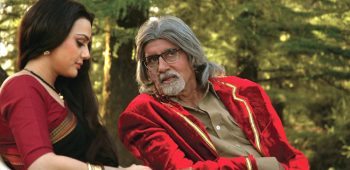
While The Last Lear may have been Bachchan’s first foray into English, it is by no means his last. He has a supporting role in this year’s Shantaram, starring Brad Pitt and Johnny Depp and directed by Mira Nair. Also for 2008, Bachchan will appear with John Abraham and Seema Biswas in Deepa Mehta’s historical epic Exclusion.
In Bengali director Rituparno Ghosh’s latest opus, The Last Lear, a reclusive stage actor is reluctantly coaxed out of retirement to play a clown in an arrogant young director’s latest film with tragic results.
The Last Lear features a cast normally associated with mainstream Bollywood: Amitabh Bachchan, Arjun Rampal and Preity Zinta in their first English feature roles. The complexity of the plot coupled with the absence of traditional Bollywood elements, such as song and dance, meant that not only were the trio making a film in a different language, they were also leaving their comfort zone in terms of style.
“I’m glad I was able to do something different,” Bachchan told ANOKHI in an exclusive interview in Toronto soon after the film’s premiere at the 2007 Toronto International Film Festival. Bachchan said that as an actor he is always seeking new opportunities and the past few years are reflective of this, with roles in unconventional films such as Cheeni Kum. Bachchan’s been using his fame to parlay his way out of the Bollywood box.
Bachchan is not the only one stretching the boundaries of mainstream cinema. The artificial line between art and commercial films is being blurred, and while there will always be “serious” films and masala movies, there’s an expanding array in the middle.

Indian producers have woken up to the appetite for diversity in film. Multiplex audiences aren’t content to see only the big spectacles with all-star casts, though they still love those. Sophisticated audiences of middle-class filmgoers want mainstream Hindi films to tell challenging stories–see Karan Johar’s Kabhi Alvida Naa Kehna, the 2006 blockbuster on love, marriage and adultery also with Bachchan and Zinta.
Lear allowed Bachchan to play homage to his stage roots and explore what it means to be an actor–this is the first time, he’s played a thespian in a film. As Ghosh pointed out in a separate interview, if Bachchan’s character Harish “Harry” Mishra had been a real person, he and Bachchan would have been contemporaries on the stage. Long before he became the Big B, a young actor trod the boards of English theatres in Kolkata. Bachchan’s stage show credits include two of Shakespeare’s most famous tragedies–Othello and Macbeth.
Lear’s script called for Bachchan to quote extensively from Shakespearean plays ranging from King Lear to Henry V. “I initially had some fear when I heard the role; Shakespeare is so well known and deeply researched,” Bachchan confided. “But the language is so intense that even if you wanted to make mistakes, you couldn’t.”

The Last Lear is inspired by Utpal Dutt’s play Aajker Shahjahan which dealt with the tension between stage and screen. Dutt had two parallel careers–he was an important actor and playwright in Bengali theatre but in Hindi cinema, he was restricted to playing the clown. Coincidentally, Bachchan’s first film 1969’s Saat Hindustani also starred Dutt.
Shahjahan was written from the point of view of a frustrated comedian. “Dutt’s play is a bitter take on the film industry,” explained Ghosh. “As a filmmaker, I’m more sympathetic to film.” In the play, the heroine is a heroin addict; in the movie, Zinta’s Shabnam is merely an under-confident actress in a troubled relationship. Rampal’s Siddharth is an arrogant young director driven by his art, and he is not as completely ruthless as the filmmaker in Shahjahan.
Theatre is an actor’s medium, but a film is controlled by the director, Ghosh said. Therefore, although The Last Lear covers the same themes, the film industry is portrayed in a much more sympathetic manner.
WORDS RITIKA NANDKEOLYAR














































































































